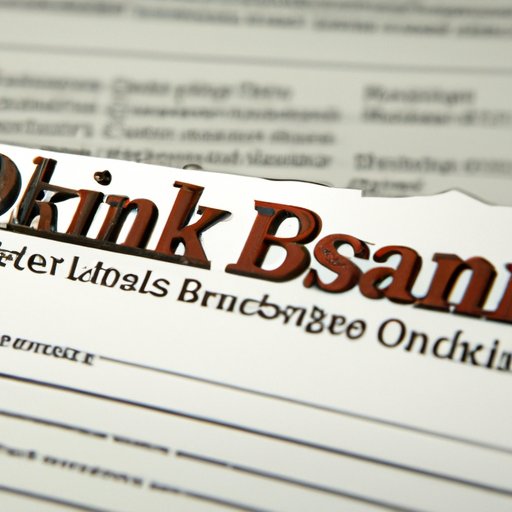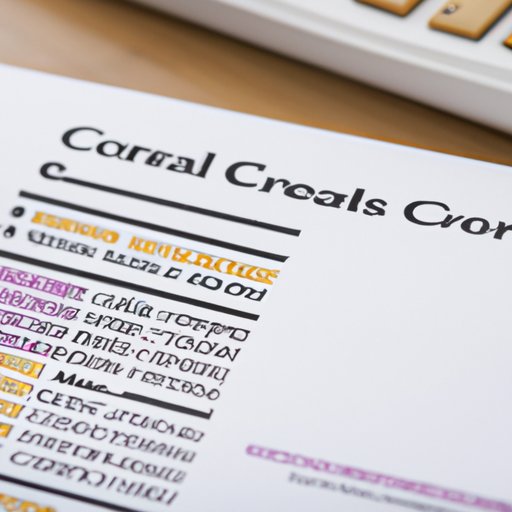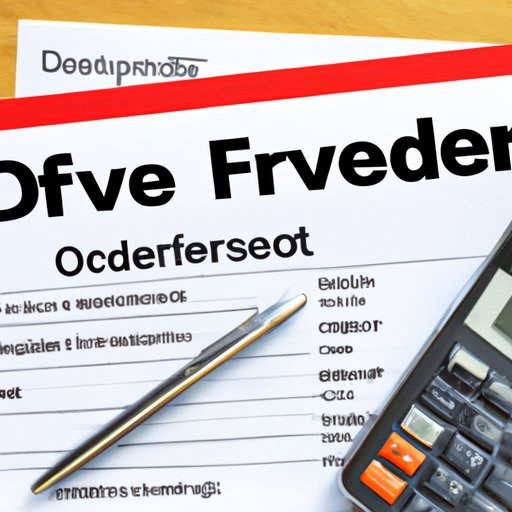Introduction
An overdraft occurs when a person spends more money than they have in their bank account. This can happen for a variety of reasons, such as making a purchase without enough funds in the account or forgetting to make a payment on time. When this happens, the bank may cover the cost of the transaction, but the customer will then be responsible for paying back the overdraft amount, plus any associated fees or interest. Understanding how overdrafts work is essential for managing finances and avoiding costly mistakes.
Explaining the Basics of Overdrafts
Before diving into the details of overdrafts, it helps to understand some of the basics. Here are some key terms to keep in mind.
What is an Overdraft?
An overdraft is an arrangement between a bank and its customer that allows the bank to cover a transaction when there are insufficient funds in the account. The bank will typically charge an overdraft fee for this service. Overdrafts can also occur if the customer makes a mistake, such as forgetting to make a payment on time.
How Does an Overdraft Work?
When an overdraft occurs, the bank will usually cover the cost of the transaction, up to a certain limit. The customer is then responsible for repaying the overdraft amount, plus any associated fees or interest. If the customer does not repay the overdraft within a certain timeframe, the bank may close the account or take other action to collect the debt.
Common Causes of Overdrafts
Overdrafts can occur for a variety of reasons. Some common causes include:
- Making a purchase without enough funds in the account
- Forgetting to make a payment on time
- Failing to keep track of account balances
- Using a debit card instead of a credit card
- Not opting-in for overdraft protection
Understanding Overdraft Fees and Interest Rates
In addition to repaying the overdraft amount, customers may also be responsible for paying additional fees or interest. Here is an overview of these costs.
What are Overdraft Fees?
Overdraft fees are charged by banks when a customer overdraws their account. These fees vary from bank to bank, but most range from $25 to $35 per overdraft. Some banks may also charge a daily fee for each day the overdraft remains unpaid.
What are Overdraft Interest Rates?
Overdraft interest rates are the interest rates charged on any outstanding overdraft balance. These rates vary from bank to bank, but most range from 15% to 25%. The higher the interest rate, the more expensive the overdraft will be.

Examining the Pros and Cons of Overdraft Protection
Many banks offer overdraft protection, which is designed to help customers avoid overdrafts and the associated fees. Here is an overview of the pros and cons of this type of protection.
Benefits of Overdraft Protection
The main benefit of overdraft protection is that it can help customers avoid costly overdraft fees. Additionally, many banks offer lower interest rates on overdrafts if the customer opts-in for overdraft protection. This can save customers money in the long run.
Drawbacks of Overdraft Protection
The downside of overdraft protection is that it can encourage people to spend more than they can afford. Additionally, some banks may require customers to pay a fee to enroll in overdraft protection, which can add to the overall cost.

Comparing Different Types of Overdraft Accounts
There are several types of overdraft accounts available, each with its own benefits and drawbacks. Here is an overview of the most common types.
Standard Overdraft Accounts
Standard overdraft accounts allow customers to overdraw their accounts up to a certain limit. Customers are then responsible for repaying the overdraft amount, plus any associated fees or interest. Most banks limit standard overdraft accounts to a maximum of $500.
Courtesy Overdraft Accounts
Courtesy overdraft accounts are similar to standard overdraft accounts, but they typically have higher limits and lower fees. However, these accounts may require customers to opt-in for overdraft protection and pay a fee to do so. Additionally, customers must maintain a certain balance in their account in order to qualify for courtesy overdraft protection.
Opt-in Overdraft Protection Accounts
Opt-in overdraft protection accounts are similar to courtesy overdraft accounts, but they typically have even higher limits and lower fees. However, customers must opt-in for overdraft protection and pay a fee to do so. Additionally, customers must maintain a certain balance in their account in order to qualify for opt-in overdraft protection.
Exploring How to Avoid Unnecessary Overdraft Charges
Overdraft charges can be costly, so it’s important to take steps to avoid them. Here are some tips for managing spending and keeping track of account balances.
Tips for Managing Spending
- Create a budget and stick to it.
- Pay off debts as quickly as possible.
- Avoid impulse purchases.
- Use cash for small purchases.
Keeping Track of Balances
- Check account balances regularly.
- Set up alerts and notifications for low balances.
- Make sure all payments are made on time.
- Review statements for accuracy.
Using Alerts and Notifications
- Sign up for text or email alerts when account balances reach a certain level.
- Set up automatic payments for recurring bills.
- Keep track of upcoming due dates.
- Enroll in online banking to monitor accounts more closely.

Analyzing How Banks Handle Overdrafts
Banks handle overdrafts differently, so it’s important to understand the policies of your particular bank. Here is an overview of how banks typically handle overdrafts.
Overdraft Policies
Most banks have specific policies regarding overdrafts. These policies may include limits on the amount of overdrafts allowed, fees for overdrafting, and whether or not the customer must opt-in for overdraft protection. It’s important to review your bank’s policies before opening an account.
Reversing Overdrafts
Some banks may reverse an overdraft if the customer pays back the overdraft amount within a certain timeframe. However, this is not always the case, so it’s important to check with your bank to see if this is an option.

Looking at the Impact of Overdrafts on Credit Scores
Overdrafts can have a negative impact on credit scores. Here is an overview of how overdrafts can affect a person’s credit score.
How Overdrafts Affect Your Credit Score
Having an overdraft on your account can negatively affect your credit score. This is because overdrafts indicate that you are living beyond your means, which can cause lenders to view you as a higher risk borrower. Additionally, if your overdraft is not paid off in a timely manner, it could lead to late payments, which can also damage your credit score.
Strategies for Improving Credit Score
If you have an overdraft on your account, there are steps you can take to improve your credit score. For example, you should make sure all payments are made on time, and you should try to pay off any outstanding debts as quickly as possible. Additionally, you can contact your bank to see if they can reduce or waive any overdraft fees.
Conclusion
Overdrafts can be a costly mistake, so it’s important to understand how they work. This article explored the basics of overdrafts, including what they are, how to avoid them, and the impact they can have on credit scores. By taking the time to understand overdrafts, you can avoid costly mistakes and manage your finances more effectively.
Summary of Key Points
- An overdraft occurs when a person spends more money than they have in their bank account.
- The bank may cover the cost of the transaction, but the customer will then be responsible for paying back the overdraft amount, plus any associated fees or interest.
- Many banks offer overdraft protection, which can help customers avoid overdrafts and the associated fees.
- There are several types of overdraft accounts available, each with its own benefits and drawbacks.
- Overdrafts can have a negative impact on credit scores, so it’s important to take steps to avoid them.
Final Thoughts
Overdrafts can be costly, but understanding how they work can help you avoid them. With the right knowledge and strategies, you can manage your finances more effectively and save yourself from unnecessary fees and interest.
(Note: Is this article not meeting your expectations? Do you have knowledge or insights to share? Unlock new opportunities and expand your reach by joining our authors team. Click Registration to join us and share your expertise with our readers.)
